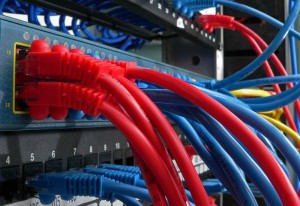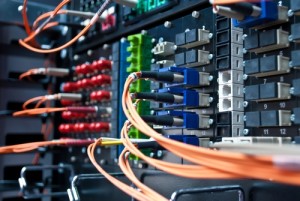fibre and copper for data transmission network
In terms of the physical infrastructure mediums the main choice is between a copper or fibre based system. So, which is the best to install? Like all good, simple questions, the route to the answer is a little more complicated. Historically, fibre was used in the backbone and copper for the horizontal cabling. However, the boundaries are no longer as clearly defined as that.
Three general areas that can influence the decision of whether to use the copper or fibre are:
- Technical
- Installation and Environment Cost
All are as important as each other, and depending on the specific location/project, will influence the argument in either direction.
Technical Decision for copper and fiber network
Starting with the technical decision, as mentioned above, the traditional principle was that fibre was used for the backbone and copper for the horizontal (to the outlet). Copper infrastructure cabling uses an electrical signal that is transmitted down the cable. A noticeable factor of electrical signals is the attenuation along the length of the cable. Horizontal copper data cabling is currently specified at a maximum channel length of 100m (this is the case for up to Category 7A/Class FA, this will change with the future Category 8.1 & 8.2/Class I & II which will be shorter). The distance of 100m for the maximum copper channel length was set as it gives the best compromise of length/performance/design for horizontal cabling. As Ethernet applications have increased in data rate,

the signalling has increased in speed and the use of all four pairs has been utilised. As the signal is split into four at the transmitter and then combined at the receiver, it is important that the delay and delay skew are allowed for within the standards. Delay is the time it takes the signal to get down each pair. The delay must not exceed the limits; otherwise the information will not be received in the time needed for the application to work at full speed duplex. As each of the four pairs are of different lengths, the signals are received at the far end at different times. This is referred to as Delay Skew – the time between the quickest and slowest pair. Too great a Delay Skew and the signal will be interrupted by the next packet. Length/attenuation is not just limited to copper, it affects fibre network too. However, with fibre the aim is to increase the distance that the application can be transmitted. With single mode fibre the minimum bandwidth is expressed as a function of frequency and distance – MHz.km. So if distances that are greater than 100m are required then fibre optic is the preference.
Copper cabling systems currently support Ethernet applications up to 10 Gigabit Ethernet. Fibre optics is able to support faster applications. For Ethernet based, these include 40 & 100 Gigabit Ethernet. Fibre network are able to employ such techniques as Parallel Optics (using more than one core to transmit the signal) or versions of WDM (Wave Division Multiplexing – using different wave lengths of light to share the data). With new methods of WDM being developed, the performance of installed fibre optics is being extended.
When it comes to power, copper has the advantage of being able to support and offer Power Over Ethernet (PoE). Power Over Ethernet delivers power with the data communication along the same cable. Assuming that the device can be driven by the power supplied by the type of PoE, then only one cable is required to the device, greatly improving the ease of installation and operation. With PoE types being developed to supply more power, and devices demanding less, there is greater scope for the application. Many products are currently available such as telephones, CCTV cameras, monitors and many more are being developed. Fibre optics has to have separately powered devices.
Installation and Environment for copper and fiber network
Installation and Environment covers both the physical deployment and the location where the system is to be sited. When looking at the physical deployment, there are attributes that are common to both medium and factors that make the installation very different. Broadly speaking, care should be given to the cable whether it is copper or fibre to ensure that the bend radius is not compromised or the pull force applied to the cable is not exceeded. These are detailed on the specification sheets and should always be observed. The termination of copper and fibre uses different equipment and skills. The equipment used for fibre splicing, especially fusion splicer machines, are costly compared to copper cabling.
To get the return on investment sometimes lends itself to installation teams specialising in fibre terminations, this can add to the mystique of fibre termination. Copper and fibre termination techniques are skills that can be obtained by competent personnel with training.Where fibre does have an advantage is containment size. An Category 6AU/FTP Screened Cable is 6.7 mm in diameter and can support one 10 Gigabit Ethernet data channel.
Compare this with an 24 Core OM4 Loose Tube Indoor Outdoor Fibre which is 6.5 mm. It can support 12 (each needing one core transmit and one core receive) 10 Gigabit channels up to 550 mm in length. So, for the same number of channels, Fibre will use less containment than Copper.
When connecting two buildings with cable, consideration has to be given to the fact that they may be on different earth systems. Cabled optical fibre is readily available in all dielectric forms. Dielectric means that it will not conduct electricity. It is therefore safe to join two buildings with all dielectric fibre or use it in hostile environments that are sensitive, including the oil and gas industry or in locations where there is a risk of
lightning strikes.
Don’t always think in a traditional way! If the network is designed to support Gigabit Ethernet to the user, using Category 6, and the backbone is 10 Gigabit Ethernet then Category 6A for the backbone may suffice if the distance is within 100m. In an office environment it can be easier to upgrade the backbone rather than the cabling to the work area. There may be room in the backbone to install a new system and “cut across” with very little disruption to the users.
Equally, the need for a data outlet in a remote location may result in a fibre optic cable being deployed as distance and earth bonding issues are overcome.
Cost for fiber network
The whole cost has to be considered when differentiating between a copper and fibre network installation. The total cost of ownership, if possible, is a better measure. So many factors affect the cost of the system, especially when the life of the network is considered (£/year). Different costs include:

- Cable
- Connectors
- Installation
- Consumables – patch cords etc
- Active Equipment
- Possible number of upgrades before need of replacement
Conclusion
Copper and Fibre are both very good cabling media each having pros and cons. Take the holistic approach and consider as many factors as possible when making your decision.